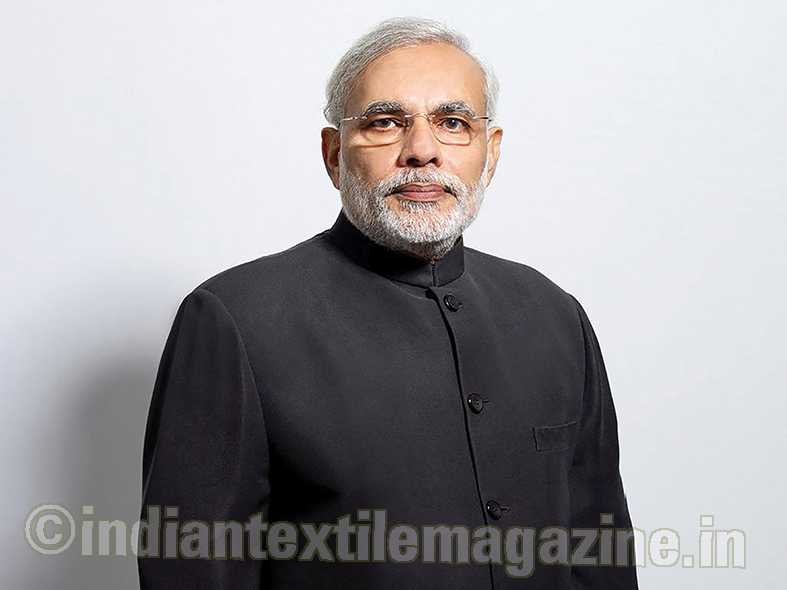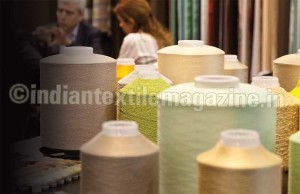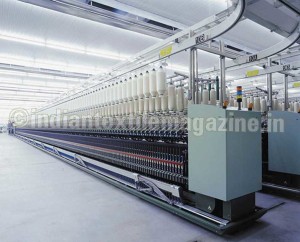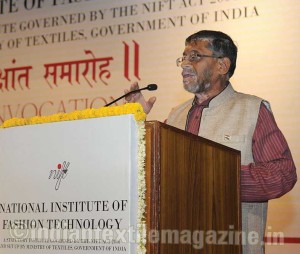Uniform growth of different segments aimed
The new Government, under the leadership of the Prime Minister, Mr. Narendra Modi, has stressed an economic vision based on increasing production, export and generating employment, giving particular attention to generation of productive employment opportunities for the youth; inclusive and participative growth; skill, scale and speed; make-in-India brand; zero defect – zero effect (on environment); and Adarsh Gram.
India’s textiles and clothing industry is one of the mainstays of the national economy. It is also one of the largest contributing sectors of India’s exports, contributing nearly 13.25 per cent of the country’s total exports basket. The textiles industry is labour intensive and is one of the largest employers and has realized export earnings worth of $41.57 billion in 2013-14.
The textile industry has two broad segments, namely, handloom, handicrafts, sericulture, powerlooms in the unorganized sector, and spinning, apparel, garmenting, made-ups in the organised sector.
The new Government has taken many initiatives for the development of the textiles sector. Some of the initiatives are as follows.
Setting up integrated textile parks
The setting up of integrated textile parks is one of the flagship schemes of the Ministry of Textiles. It aims to assist small and medium entrepreneurs in the textile industry to clusterize investments in textile parks by providing financial support for world class infrastructure in the parks.
The implementation of the scheme was held up during the last one year due to administrative bottlenecks, and no sanction was given for new parks. The new Government moved swiftly to resolve the issues, and 13 new textiles parks were approved by the Project Approval Committee (PAC) chaired by the Minister of State for Textiles (independent Charge), Mr. Santosh Kumar Gangwar. While these 13 textile parks will receive a grant of Rs. 520 crores from the Government for infrastructure development, they are estimated to bring in private sector investment of about Rs. 3,240 crores to generate direct employment for about 35,000 persons over the next three years. Besides, a fresh advertisement would be issued calling for proposals for more ITPs for utilization of the balance provision during the 12th Plan period.
Exports
During April-August 2014, textile exports registered a growth of 9.5 per cent against the corresponding period of last year, while RMG exports grew 17.7 per cent and carpets 22.2 per cent.
Handloom development
Specific steps have been initiated for revival of the handloom industry, based on its inherent strength, for production of high value items. Focus is on assisting weavers with designs, marketing and improved wages. The National Institute of Fashion Technology and leading members of the fashion industry have been roped in for design support to weavers. At the same time, equipment and raw material for producing clothes for the high-end customers and niche market are also being provided. Higher wage coming from high value production and reducing the level of transactions in marketing would enhance the wage of the handloom weavers substantially.
In order to provide better marketing reach, the Ministry has launched an E-commerce initiative Flipkart. This will strengthen the existing primary weaver co-operative society by assisting entrepreneurs from the weavers’ families for taking up production and supply directly to the customers. The proposed Trade Facilitation Centre and a Craft Museum will also provide the much-needed visibility to handloom products. Lakme fashion week this year dedicated a day showcasing the vibrancy and magic of Indian weavers and crafts.
Synergy of handloom and handicraft with tourism has been worked out in consultation with the Ministry of Tourism. State Chief Secretaries have been requested to identify traditional handloom weavers/handicraft artisans villages for development as “Adarsh Gram” as tourists’ destination.
Development of Tassar handloom products like sarees, dress material and a wide range of home furnishing fabric for exports typical to Bhagalpur in Bihar has been initiated under the Handloom Mega Cluster Scheme. Another mega cluster is being developed at Trichy. Over 15,000 handloom weavers will be directly benefited under each of these two clusters. The remaining new mega-clusters at Surat, Bareilly, Lucknow, Kutch and Mysore announced in the Finance Minister’s Budget speech are at various stages of implementation.
Handicraft
Promotion of major crafts of Varanasi, namely, wood carving, carpet and durry weaving, meenakari and zardozi and pottery, etc., have been taken up by providing assistance to the artisans with better skill, design and supply of toolkits, etc. This was formally launched by the Textiles Minister on September 26.
A Skill Development Programme for training 5,000 carpet weavers has been taken up through the Carpet Export Promotion Council (CEPC). An Integrated Design Project of five months duration for wooden toys would be organized by the National Centre for Design and Product Development (NCDPD). Electric wheels were given to potters under the Design and Technological Upgradation Scheme of Handicrafts in Delhi and later at Bareilly.
Silk and Pashmina
India is the second largest producer of silk in the world and employs a large number of skilled and unskilled tribal women. During his recent visit to Jammu & Kashmir the Prime Minister declared a scheme for the development of nomads.
Provision of Rs. 30 crores for the same was made in the 2014-15 Budget, which would be utilized for promotion of Pashmina in Leh in the Ladakh region of Jammu and Kashmir, setting up a dehairing plant in Ladakh to increase productivity and for setting up solar powered community centers, sheds for animals and pucca shelters for nomads.
Recognizing their contribution and efforts, the Textiles Minister felicitated 54 women engaged in sericulture.
With a vision to encourage and train the youth of Jammu and Kashmir for fashion design and thereby generate employment opportunities, the Government has increased its financial support for setting up the NIFT centers in Srinagar from 50 per cent to 90 per cent.
|
With a vision to create an export-friendly economy, the Government introduced the following initiatives: • Duty-free entitlement to garment exporters for import of trimmings, embellishments and other specified items increased from three per cent to five per cent. This initiative is expected to generate an additional RMG exports of Rs.10,000 crores. • The Government has proposed to extend 24/7 customs clearance facility at 13 airports and 14 sea ports, resulting in faster clearance of import and export cargo. • The proposal for imposing duty on branded items was dropped, providing relief to the entire value chain. |



